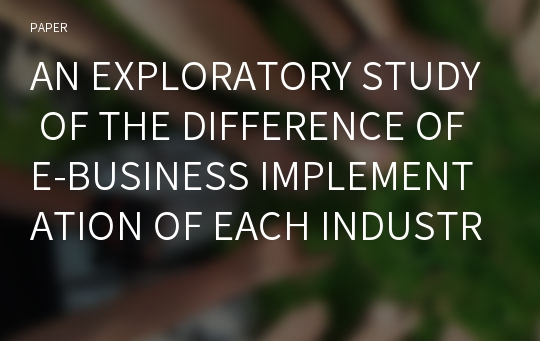AN EXPLORATORY STUDY OF THE DIFFERENCE OF E-BUSINESS IMPLEMENTATION OF EACH INDUSTRY IN JAPAN
* 본 문서는 배포용으로 복사 및 편집이 불가합니다.
서지정보
ㆍ발행기관 : 글로벌지식마케팅경영학회(GFMC)
ㆍ수록지정보 : Global Marketing Conference
ㆍ저자명 : Masahiro Maruyama
ㆍ저자명 : Masahiro Maruyama
영어 초록
This exploratory study conducts the difference of e-business implementation of each industry in Japan. According to factor analysis, 9 e-business contents are classified into four factors. Then, as a result of cluster analysis using the four factors, industries are classified into five clusters according to the grade of execution of e-business, and the contents of execution. Online networks including internet have given rise to the digital economy to support electronic business (e-business) activities. But it varies according to a type of industry because how enterprises perform e-business. The purpose of working on e-business is also the same. This study shows that the implementation status of e-business of each industry. E-business using online networks are various, such as not only e-commerce but also activities inside the company. The former examples are sales or purchase trading, and the latter examples are activities of a direct department called production or physical distribution, and a back-office section called accounts or personnel. In addition, purposes of enterprises perform e-business may be various, for example sales expansion, and cost reduction, information sharing. In Japan, before the Internet known as an open online network spreads, former closed online network such as VAN; Value Added Network has been popular to companies in 1980’s. Therefore, companies could use e-business in internal business process integration or to specific partners. The examples are Electronic Data Interchange (EDI), Supply Chain Management (SCM), Enterprise Resource Planning (ERP). But in fact, e-commerce is more popular than other e-business. That may be why effects come out of e-commerce in the short term, such as reduction of office work cost, improvement in customer satisfaction, or the reduction of an input cost. Iacovou et al(1995) recommends the development of successful EDI partner expansion plans, which include EDI initiators pursue promotional efforts to improve partners’ (especially small partners’) perceptions of EDI benefits, provide financial and technological assistance to partners with low organizational readiness, and carefully select and enact influence strategies to reduce resistance. Fisher(1997) concludes the effectiveness of SCM varies according to the matrix of product properties and purpose of SCM. From the viewpoint of marketing partnership, Doney et al(1997) shows that supplier size and supplier's willingness to customer have a positive impact on buyers’ trust. Chatterjee et al(2002) shows that companies structuring e-commerce platform should have top management championship, strategic investment rationale, and extent of coordination. According to these studies, the effectiveness of e-business changes in the factor inside and outside the company such as the relations with a type of industry and the trading partner. MTI(2006) shows the result of a questionnaire companies of Japan and USA why to introduce e-commerce. According to this survey, Japanese companies think as important cost reductions, such as a request from a customer, and increase in efficiency of ordering business, to the USA companies think as important sales expansions, such as new customer acquisition and expansion of a sales channel. SMEA(2009), belongs to MTI, shows SMEs which consider “reduction of trading costs” to be a benefit are greatest in number, but when looked at in terms of employee size, the smaller the enterprise, the larger the number citing that it is “easy to acquire new customers.” These suggest engaging e-commerce actively is important as a means of acquiring customers for small companies as well. MIC(2012) shows the result of an annualy mail survey with about 2,000 enterprises; 87.5% of companies have built a company communication network such as internet, the percentage of businesses using e-commerce (procurement/sales via the Internet) is 44.5%, and the percentage of businesses using at least a part of a cloud computing serviceis 21.6%, which is 7.5 percentage points more than the 14.1% rate at the end of 2010. This study conducts a statistical secondary analysis using large-scale survey. The original survey is “Results of the Basic Survey of Business and Activity on March 31, 2009” provided Ministry of Economy, Trade and Industry in Japan. The survey is somewhat old because they survey each 5 years. The survey is a mail on self-declaration forms given to enterprises which engaged in business with both a minimum capital of 30 million yen and 50 or more employees. Questions include size and profit of enterprises, online network usage and e-business implementation. It covers over 28,000 enterprises which operate mining, manufacturing, and wholesale and retail trade, and eating and drinking places. This study analyzes the semi total data for every 103 types of industry because the reply for each enterprise is not disclosed, and conducts descriptive statistics. An exploratory factor analysis revealed 4 factors from 10 variables on a sample of 103 industries. Table1 shows that pattern matrix after Promax rotation with Maximum Likelihood extraction. As the factor loadings of Sales, Inventory and Distribution are high, 1st factor can be named as “Sales division”. Like the following, 2nd factor is “In-company management”, 3rd factor is “Procurement” and 4th factor is “Manufacturing”. e-business implementation can be classified into “Sales division”, “I n-company management”, “Procurement” and “Manufacturing”. This suggests the priority matter of each enterprise is reflected. First, a type of industry to suffer from the competition with others by sales markets to work on customer satisfactions or marketing tackles “Sales division”. Second, “In-company management” could be important for a type of industry to push forward information integration and employee management in the enterprise or the cost cut of the indirect section. Third, Industries which work on cost reduction with strong bargaining ability to the supplier could be tackling “procurement” e-business. And some manufacturing industries work on “manufacturing” e-business. In order to classify 103 industries according to e-business implementation, cluster analysis is conducted with factor scores observed the analysis. Figure 1 is a result of hierarchical cluster analysis applying the Ward Linkage method. It is divided into five clusters. Table 2 is average factor score & characteristics of each cluster. The analysis shows the characteristic of the type of industry to perform e-business. Cluster 5 which contains only electricity is firstly classified as other types of industry. The cluster has the highest score except “Sales Division” than other clusters. Cluster 3 and 4 work on e-business more positively than Cluster 1 and 2. Cluster 1 has very low score especially “Sales division” and “In-company management”. The reason may be why it has traditional manufacture such as mining and wood manufacture. Cluster 2 has also low score especially “Manufacturing” because it has traditional distributor sector such as apparel, agricultural or furniture wholesales. Therefore, “Sales Division” is performed better than other e-business. On the other hand, Cluster 3 has high score other than manufacturing because it has non-store retailer and electrical or motor wholesales. Many of them work on e-commerce because they satisfy customers and compete with others, and procure products to reduce costs. And Cluster 4 has major manufacture industries such as electronic, motor vehicles and communication, which work on e-business totally. In conclusion, the difference of e-business implementation of each industry reflects on market structure. This study has two limitations. First, as the data used for this analysis is already totaled for every type of industry, the reply situation for each company is not reflected. Though the government statistics are collecting data comprehensively, it is very rare to have released each data because of privacy. After taking into consideration in a respondent's privacy, an indication of individual data is desired. Second, the purpose or attitude companies work on e-business are not taken into consideration though analyzed based on the implementation rate of e-business. Not only action data but attitude data and consciousness data are important. The future research should analyze why companies work on e-business through an interview or questionnaire survey.참고 자료
없음"Global Marketing Conference"의 다른 논문
 THE ROLES OF GREEN PACKAGING IN UGLY FOOD PURCHASE INTE..22페이지
THE ROLES OF GREEN PACKAGING IN UGLY FOOD PURCHASE INTE..22페이지 THE IMPACT OF INDUCED AWE ON ETHICAL TOURIST BEHAVIORS5페이지
THE IMPACT OF INDUCED AWE ON ETHICAL TOURIST BEHAVIORS5페이지 A BIBLIOMETRIC ANALYSIS OF SPIRITUAL TOURISM RESEARCH15페이지
A BIBLIOMETRIC ANALYSIS OF SPIRITUAL TOURISM RESEARCH15페이지 SOCIAL NETWORK ANALYSIS AND RESPONSE TIME TESTING: CONS..11페이지
SOCIAL NETWORK ANALYSIS AND RESPONSE TIME TESTING: CONS..11페이지 THE EFFECTS OF PARA-SOCIAL INTERACTION ON ONLINE CELEBR..3페이지
THE EFFECTS OF PARA-SOCIAL INTERACTION ON ONLINE CELEBR..3페이지 THE INFLUENCE OF OPINION LEADERS ON DAILY DEALS USER’S ..3페이지
THE INFLUENCE OF OPINION LEADERS ON DAILY DEALS USER’S ..3페이지 HOW IMMERSIVE RETAILING AFFECTS CONSUMERS’ URGE TO BUY:..6페이지
HOW IMMERSIVE RETAILING AFFECTS CONSUMERS’ URGE TO BUY:..6페이지 KEY TO SUPERSTARDOM IN A GLOBALISED MARKET: THE ROLE OF..6페이지
KEY TO SUPERSTARDOM IN A GLOBALISED MARKET: THE ROLE OF..6페이지 A POST-PANDEMIC LOOK AT TOURISTS’ PERCEIVED COOLNESS OF..4페이지
A POST-PANDEMIC LOOK AT TOURISTS’ PERCEIVED COOLNESS OF..4페이지 EXTRACTING OFFLINE RETAIL SHOPPING PATTERNS: OLLABORATI..5페이지
EXTRACTING OFFLINE RETAIL SHOPPING PATTERNS: OLLABORATI..5페이지


















